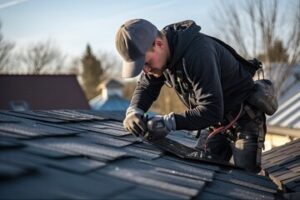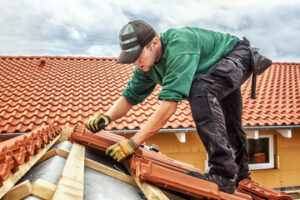A roof’s lifespan depends on the type of roofing materials and environmental factors. A properly maintained roof can last for many years before it needs repairs or a full replacement.

Local repair options include replacing missing shingles, addressing leaks and applying elastomeric coatings. Improved drainage and regular maintenance can also reduce the need for repairs. Contact Roof Repair Columbus GA for professional help.
Without a doubt, damaged shingles are the most common roof repair issue. Shingles are highly durable and designed to withstand a lot of wear and tear, but high winds and falling debris can damage or loosen them up to the point where they need to be replaced.
Cracking, chipping or missing shingles should also be repaired as soon as possible to prevent water penetration and further damage to your home. Dark spots or streaks on shingle surfaces could indicate algae growth, which can also be detrimental to your roof over time.
While you’re at it, check that the flashing around chimneys, vents and skylights is intact and not compromised. This material seals the edges and joints of your roof to keep moisture out, so damage or looseness can quickly lead to leaks.
Assemble your roof repair tools, including a ladder, pry bar, hammer and utility knife. You’ll also need a bundle of replacement shingles that closely match your existing shingles. If you’ve got leftover shingles from previous roof work, that will be even better, but new shingles are easy to find at home improvement stores.
To replace a damaged shingle, start by sliding the new one into place. Line it up correctly and then secure it with roofing nails. Be sure to use a generous amount of roof cement over the seams and nail heads to seal in the shingle.
If a shingle is cracked, apply some roof sealant beneath the damaged section and then press a shingle strip into the crack. Spread the sealant evenly with a putty knife and then cover it with shingle granules to camouflage your repair.
Check the gutters for a buildup of colored shingle granules that can be collected and sprinkled over wet sealant to camouflage crack repairs. Make sure to inspect the entire roof for additional damage or leaking areas before calling in a professional roofer. Identifying and repairing issues like these early on can save you money in the long run by preventing further problems. A thorough roof inspection should be performed at least twice a year to catch potential problems before they get out of hand.
Leaks
A leaky roof can create serious and expensive problems. It’s important to know the warning signs of leaks, so you can catch them early and get your roof repaired.
Water stains on the ceiling or walls are often the first indication of a problem, though they’re not always easy to spot. You may also notice discolored patches in your attic or walls, a musty smell, or damp insulation. Moisture can also cause paint to bubble or wallpaper to peel, which are more obvious symptoms of a roof leak.
Leaks can be caused by many factors, including damaged asphalt shingles, poor flashing installation, or clogged gutters. If you’re not sure where the leak is coming from, it’s best to consult a professional roofer for advice.
The most common way to repair a leak is by covering the area with a tarp and using a heavy-duty sealant. This will prevent further water intrusion and minimize any interior damage. You should also take the opportunity to re-seal areas where necessary, such as around chimneys, vents, and skylights.
If you’re unsure where the leak is coming from, you can try to identify the source by testing your roof during rainy weather. While standing safely on the roof, use a garden hose to simulate rainfall. Start by spraying the area directly above where you suspect a leak is occurring. Then, direct the hose to the left and right to isolate the source of the leak.
If the leak is found, it’s time to fix it! Be sure to remove any debris and clean the area before starting work. If you’re tackling flat roof leak repair, it’s a good idea to wear rubber-soled footwear, safety goggles, and a harness with a fall arrest system to avoid injuries. Once the area is cleaned and dry, cover the leaky area with a tarp to prevent further damage. Then, use a high-quality roofing sealant to fix the hole and prevent future leaks. Be sure to test the area again after the sealant has had a chance to set. If you continue to experience leaks, consider a full roof replacement.
Gaps
Gaps between roof and gutter systems can negatively impact the structure of your home. Rainwater and snow melt should flow through the gutter channels and downspouts to prevent water from seeping under roof shingles, causing damage and rotting over time. The gap between roof and gutters can also allow moisture to seep into the siding or foundation of your house, leading to mold and structural damage. Fortunately, gaps between the gutter and roof can be fixed with proper maintenance and regular inspections.
One common gap that many homeowners are unaware of is a builder’s gap, which is created when the shingle decking does not align with the fascia board during construction. This gap is meant to improve attic ventilation, but it can also let water, insects, and other debris into your home.
Another potential source of gaps is the flashing that surrounds chimneys, vents, and skylights. This metal flashing seals the joints and edges on your roof to protect against leaks, but if the flashing is damaged or deteriorated, it can create a hole for water to enter your home. Inspect the flashing regularly, and replace it if necessary.
Other common gaps are caused by sagging or loose gutters, which can pull away from the roof edge and cause water to escape from the gutters. These gaps may also lead to landscaping erosion or water damage to the siding and foundation of your home. If you notice sagging or loose gutters, contact a professional gutter installation company to realign and repair them.
If you notice that your roof is leaking near vent areas, it’s likely a sign that the vent seals have deteriorated and need to be replaced. Using roofing cement or sealant can help to fill these gaps and ensure that the area is protected from rainwater and other elements. Also, make sure to periodically check that the vents are not blocked by debris or that they have not been covered by ice dams. This can help to prolong the lifespan of your roof and improve energy efficiency throughout your home.
Cracks
If a roof is well-maintained, it can help retain value and protect your home investment. Regular maintenance and inspections can detect problems that are easy to fix, such as cracked tiles or shingle cracks. However, cracks in your ceiling can indicate structural damage and other serious issues if left unchecked for too long. This is why it is important to identify and repair cracks in your home as soon as possible.
The presence of cracks in your ceiling can be a warning sign of structural damage, water leaks, and other issues with the structure of your home. Often, this damage can be caused by the weather and climate conditions in your area. However, cracks in the ceiling can also be caused by poor drywall installation or by age-related changes in the structure of your home.
If the cracks are only fine, hair-thin straight or spiderweb shaped and don’t show any signs of discoloration, they may be nothing to worry about. Plaster has a tendency to crack over time, and minor cracks in plaster ceilings are not uncommon. They typically don’t need to be repaired immediately, but if they are accompanied by sagging or discoloration, it’s a good idea to contact a roofing company for a professional assessment and repair.
Cracks that are yellow, brown or otherwise discolored usually indicate leaks and water damage. You can use roofing tape or sealant to temporarily stop the flow of water, but this is not a permanent solution. It’s best to have the cracks fixed by a professional, who can provide you with a durable and permanent repair.
Another cause of cracks in your roof is damage to the protective membranes that lie underneath the tiles. If these membranes become tattered, torn, or punctured, they can allow rainwater to penetrate the roof and cause damage to the insulation and other structures of your home.
